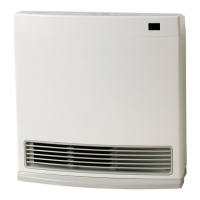Infinity REU-V1616W / REU-V1620W / REU-V2018W / REU-V2020W- 15 - Issue 2 - 21/03/06 ©Rinnai
9. Main Components
1) Printed Circuit Board
• The Printed Circuit Board controls all operational functions including Air Supply Control, Gas Control,
Water Flow Measurement, Water Flow Control, Combustion System and all sensors and safety devices.
2) Gas Flow Control
• During normal operation, the PCB keeps the main solenoid valve open whilst there is flow through the
unit and the burner needs to be lit.
• Gas flow rate is controlled by the modulating valve assembly and three changeover solenoid valves to
always ensure constant outlet water temperature, regardless of flow rate or incoming water temperature.
• The modulating valve is electronically controlled by the PCB using signals from the water flow sensor,
water flow control device, water temperature thermistors and combustion fan speed sensor. The
modulating valve directs gas to the three changeover solenoid valves.
• The three changeover solenoid valves direct gas to each of the two burner banks independently. Any one
or two or both of the solenoid valves may be open during operation.
• Gas flow is modulated between 18 and 125 MJ/hr for REU-V1616W/REU-V1620W and between 20
and 160 MJ/hr for REU-V2018W and REU-V2020W by a combination of the modulating valve and
changeover solenoid positions.
• The maximum gas rate is predetermined and the appliance cannot be overloaded when correctly
installed.
3) Water Flow Control
• Water flow is detected by a turbine coupled to a magnetic pulse generating device. The magnetic pulses
are detected and counted by the PCB. The PCB calculates the exact water flow from the frequency of
pulses generated by the turbine. A minimum flow rate of 2.4 L/min. is required for the burner to ignite.
• Water flow control is achieved through the use of servo driven water flow and fixed bypass. Servo
motor is controlled by the PCB. The ‘Water Flow Valve’ restricts the flow of water into the heat
exchanger assembly if the programmed temperature cannot be achieved. During normal operation, cold
water from the inlet valve is mixed with hot water from the heat exchanger outlet.
• The ‘Bypass’ mixes cold and hot water to ensure hot water delivery temperature over the available range
of flow rates.
4) Air Supply Control
• Air for combustion is supplied by a centrifugal fan driven by a variable speed DC motor. The voltage to
the motor is determined by the PCB based on water flow, delivered water temperature and programmed
water temperature. The actual fan speed is monitored by a magnetic pulse counter. This counter emits a
signal to the PCB. From the voltage supplied to the DC motor and the fan speed signal, the PCB
determines whether an error condition exists with the fan.
5) Combustion System
The combustion chamber is housed within the heat exchanger assembly and comprises:
• Aluminium alloy manifold with a total of 28 integral injectors. Gas flow to each chamber is controlled
by an electronic solenoid valve (refer ‘Gas Flow Control’ above).
• A burner assembly comprising fourteen identical modular stainless steel bunsen burners secured by an
aluminised steel framework. The manifold is attached to the front of the burner module. Each bunsen
burner is supplied by two injectors.
• A combustion chamber. Integrated into the combustion chamber front panel are the flame rod and two
ignition electrodes.

